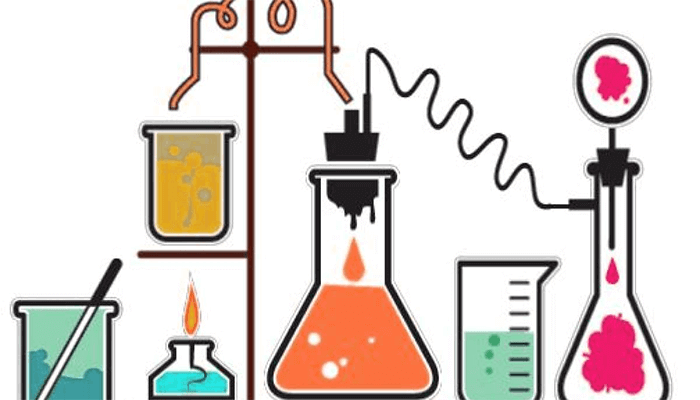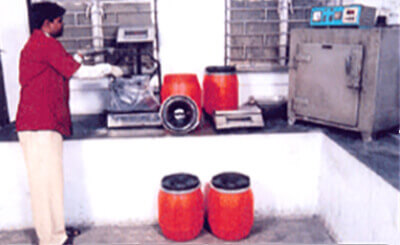Raney Nickel Catalyst (Active)
Raney Nickel is a versatile Hydrogenation Catalyst and is used in Hydrogenation of the large number of functional groups notable among them being Carbon-Carbon double bond, Carbonyl (aldehydic and ketonic), Nitro, Azide, Nitrile, Oxime groups. It is also used in Hydrogenolysis (viz dehalogenation, debenzylation) and Desulfurisation reactions.
Raney Nickel can also be used in hydrogenation reactions involving very high pressure and temperature. Due to its ability to hydrogenate virtually any type of functional group Raney Nickel is likely to hydrogenate most of the functional groups present on the molecule (of course to varying degrees) capable of getting hydrogenated. Raney Nickel is therefore termed as non-specific catalyst.
Raney Nickel is highly pyrophoric when dry i.e. catches fire when allowed to dry in the atmosphere and is therefore always kept submerged under water or a suitable solvent such as Ethanol, Cyclohexane, Dioxane etc. Even though Raney Nickel Catalyst (Active) is always kept submerged underwater or a suitable solvent and supplied in that manner, the commercial transactions are done on a dry weight basis.
Notable applications are in the manufacture of Sorbitol, rubber additives, dyes & drugs intermediates, pesticide intermediates, Caprolactam, etc. Raney Nickel Catalyst can be used in batch as well as in continuous hydrogenation process.
Unlike most other Hydrogenation catalysts, it is not instantly poisoned by sulfur radicals if present in the reactants. However, finely divided Nickel particles due to a strong affinity for sulfur instantly react with a sulfur present in any form in the molecule of the reactant. Due to its this special property Raney Nickel is frequently used for desulfurization reactions.
Raney Nickel can also be used for dehydrogenation reactions.
Limitation of Raney Nickel is that it cannot be used in acidic reaction conditions especially pH below 5.5 because at that pH fine Nickel particles will start dissolving in the reactant/solvent, leading to a rapid decline in activity.
Grades of Raney Nickel Catalyst (Active) :-
At Vineeth Precious Catalysts Pvt. Ltd., based on our customers need, in general we make four grades which have been coded as RNP, RNM, RNK-F, RNK Technical Specifications for these grades can be obtained by contacting our manufacturing site.
Besides, company has capability of making Raney Nickel as per customer's specification such as very low activity, non-pyrophoric, neutral pH, low slurry density, high slurry density, special for Carbazole, special for de-sulfurisation, Molybdenum or Chromium promoted catalyst. Our catalysts are easy to filter and are guarded against small amounts of oxidants.
Shelf Life :-
The assured shelf life of the product is one year from the date of manufacture with retest period of six months.
Packing :-
The standard packing is 5 kg and 10 kg (calculated and reported as weight on dry basis) in M.S Drums or HDPE Drums. The packing size however can be tailored to customers specific requirements.
Certificate of Analysis (COA) is made available to all the customers irrespective of quantum of supply. Material safety information, technical specification and test methods however are supplied against specific request.
Reactivation of Spent Raney Nickel Catalyst :-
We have developed techniques of reactivation of spent catalyst and the job work is undertaken on commercial basis. Use of reactivated catalyst can substantially reduce the cost of hydrogenation. It should however be noted that use of reactivated Raney Nickel Catalyst should be restricted to the specific products alone from which the spent got generated.

For further details please feel free to contact General Manager, Vineeth Precious Catalysts, Pvt. Ltd.
Dry weight calculations for Raney Nickel Catalyst (Active) :-
Raney Nickel Catalyst (Active) due to its pyrophoric nature, is always supplied as submerged underwater. Its commercial transactions however are done on the basis of its dry weight. Weight on dry basis of a given pack can be determined as follows :
- Take a clean transparent / semi transparent plastic bucket of size sufficient enough to accommodate entire quantity of the catalyst slurry along with supernatant water.
- Transfer the entire quantity of the catalyst slurry along with supernatant water into this plastic bucket. Additional water (de-mineralized) can be used for ensuring complete transfer. Put a mark with the help of an indelible marking pen on the exterior or the bucket at the upper level of supernatant water. Now weigh this bucket along with catalyst and water. Let this weight be G.
- Empty out the bucket. Remove the catalyst completely. Fill up the bucket upto the same mark with de-mineralized water. Again weigh the bucket. This time the weight is due to bucket and water only. Let this weight be W.
Weight of given quantity of catalyst on dry basis = 1.22 x [G-W]
Palladium on Carbon Catalysts
Palladium on Activated Charcoal is also known as Palladium on Carbon (Pd on C) is a mild hydrogenation catalyst. It is generally a catalyst of choice when the functional group to be hydrogenated is a part of a molecule which has also got some other functional group capable of getting hydrogenated. It is also a catalyst of choice for getting a specific type of isomer. It is, therefore, a catalyst for selective hydrogenation. Further, it can also be safely used where the reaction conditions are acidic, viz. where acetic acid is a solvent or dilute sulphuric acid or di-hydro chlorine is additive.
Vineeth Precious Catalysts Pvt. Ltd., Vasai, makes two standard grades of Palladium on Carbon. Different grades are made for attaining better yield and efficiency with different type of reactions. These two grades can meet requirements for all types of hydrogenation reactions where palladium on carbon is recommended catalyst. Whereas Grade 390 Z is less powerful but more stable, Grade 390 V is very powerful but has a short shelf life.
In each of these two grades, palladium loading can be made as per customer’s requirements. For reasons of economy, it is quite customary to use the same catalyst for more than one cycle of hydrogenation before it is sent to the manufacturer for recovery of palladium metal for an eventual reformulation of fresh catalyst. However, if the nature of the reactants and the end products are such that the catalyst gets deactivated or poisoned after one cycle only, it is advisable to opt for lower palladium loading viz. 1% or 2% instead of standard 5% or 10%.
Palladium on Carbon Catalyst, especially when Palladium loading is high, is usually supplied in Wet Form, i.e with 50% water because of pyrophoric nature of dry powder in the environment of Hydrogen. Catalyst powder in dry form is however used when presence of water is totally undesirable.
A reference table annexed herewith shows which grade is more suitable for a particular type of reaction. The recommendation given in the table should however be taken as a suggestive one and not an ultimate one.
Certificate of Analysis (COA) is made available to all the customers irrespective of quantum of supply. Material safety information, technical specification and test methods however are supplied against specific request.
Packing :-
Standard packing is 1 kg, 2 kg and 5 kg in wet or dry form as per customer's requirement.
Shelf Life :-
30 days from the date of manufacture for Grade 390 V and 90 days from the date of manufacture for Grade 390 Z
Note :-
- Different Grade Nos of Catalyst are on account of different grades of activated charcoal used and different techniques adopted at the time of making of the catalyst.
- All the above catalysts can also be supplied in wet form with 50% water
GRADES OF PALLADIUM ON CARBON CATALYSTS & THEIR TYPICAL APPLICATIONS
| Catalyst Grade | Palladium Content |
Typical Application |
| 300 Z | 2.0% |
Carbonyl Reduction |
| 300 V | 2.0% |
C-N and C-O cleavage |
390 Z |
2.0% |
Rosenmund Reduction |
390 V |
2.0% |
Debenzylation Dehydrogenation |
| 153 V | 20% Pd (OH)2 on Carbon |
Debenzylation |
Safety, Storage, Shelf Life, Handling and Disposal
- Raney Nickel Catalyst (Active) is highly pyrophoric when it gets dried up on exposure to air/ atmosphere/ oxygen. It should therefore always be kept under demineralised/ distilled water.
- The containers of the catalyst should be stored in a cool and ventilated place protected from direct exposure to sunlight.
- Protective gloves, shoes and goggles must be used while transferring catalyst from containers to the reaction vessel.
- Hydrogen gas continuously evolves from the catalyst slurry. Smoking cigarette/ bidi and lighting matchstick/ lighter should be strictly prohibited while opening the containers of the catalyst.

- The catalyst slurry should be manually stirred using a steel rod / spoon to restore it in suspension for easy and smooth transfer.
- Care should be taken while transferring catalyst so as to avoid/ minimise spillage of the catalyst. skilled personnel should be employed for handling the catalyst.
- In the event of spillage of small quantity, the spilled material may be deactivated by using a 0.5 % solution of potassium permanganate followed by flushing the area with sufficient water.
- In the event of spillage of significant quantity, the spilled catalyst slurry should be collected back manually and put in a polythene bag thereafter be packed in a plastic or M.S.Container and retrieval of the spilled catalyst should be flushed with water. A 0.5 % solution of Potassium Permanganate [KMnO4] may also be used as an additional measure.
- In the event of contact with skin, the skin should be washed immediately with running water. Dry with a clean towel and apply a soothing ointment (viz soframycin).
- Empty polythene bags and containers after transfer of catalyst should be washed profusely with water before scrapping them.
- Great care should be taken in deciding temperature and pressure condition and selection of solvent for the hydrogenation reaction.
DISPOSAL PRECAUTIONS :-
Nickel is a costly metal. Do not therefore discard even such of the spent Raney Nickel Catalysts which can not be reactivated any more.
Even such a material can fetch good money from the manufacturers of Nickel salts.
- As far as possible use wet form of the catalyst.
- It can cause a fire when dry mixed with Methanol. For reactions using Methanol as a solvent, first, mix the catalyst with water to form a paste before charging the catalyst into the reactor.
- During the transfer of dry catalyst powder (from its plastic bag) into the reactor, it can catch fire due to the static charge generated due to the abrasion of dry catalyst powder with a plastic bag (container). Therefore do not empty out the bag into the reaction vessel at once with force. Add slowly.
- During filtration and thereafter do not allow spent catalyst to dry due to vaporization of the solvent. Give D.M. Water washing after solvent removal. Pack and transport in wet cake form for recovery and regeneration.
- In the event of a fire, contain it by pouring water. After a fire has been put off, collect all the wet residues manually and pack the same in a plastic bag and send it to Vineeth Precious Catalysts Pvt. Ltd., Vasai, for recovery of Palladium/ Platinum metal and consequent conversion into the fresh catalyst.
- Inhalation of catalyst powder can cause irritation of the respiratory tract. Therefore use a mask while handling this product.
- In case of powder particles coming into contact with skin or falling into eyes, wash the affected part of the body or eyes profusely with water.
DISPOSAL PRECAUTIONS :-
Palladium/ Platinum on Carbon Catalyst is a costly product. The precious Palladium/ Platinum metal from the used catalyst can be recovered. Do not, therefore, discard the used product as waste material. Arrangements should be made to send back the material to the manufacturer for recovery of the precious Palladium/ Platinum Metal which can be reused for making a fresh batch of the catalyst.